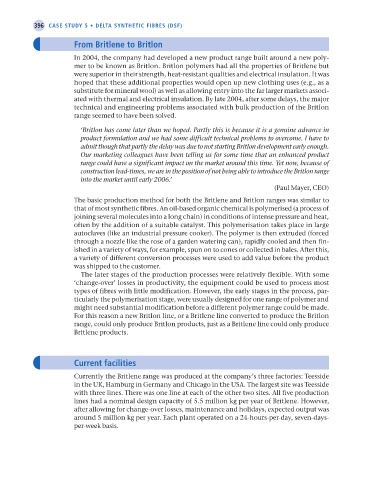Page 421 - Operations Strategy
P. 421
396 case study 5 • delta synthetic Fibres (dsF)
From britlene to britlon
In 2004, the company had developed a new product range built around a new poly-
mer to be known as Britlon. Britlon polymers had all the properties of Britlene but
were superior in their strength, heat-resistant qualities and electrical insulation. It was
hoped that these additional properties would open up new clothing uses (e.g., as a
substitute for mineral wool) as well as allowing entry into the far larger markets associ-
ated with thermal and electrical insulation. By late 2004, after some delays, the major
technical and engineering problems associated with bulk production of the Britlon
range seemed to have been solved.
‘Britlon has come later than we hoped. Partly this is because it is a genuine advance in
product formulation and we had some difficult technical problems to overcome. I have to
admit though that partly the delay was due to not starting Britlon development early enough.
Our marketing colleagues have been telling us for some time that an enhanced product
range could have a significant impact on the market around this time. Yet now, because of
construction lead-times, we are in the position of not being able to introduce the Britlon range
into the market until early 2006.’
(Paul Mayer, CEO)
The basic production method for both the Britlene and Britlon ranges was similar to
that of most synthetic fibres. An oil-based organic chemical is polymerised (a process of
joining several molecules into a long chain) in conditions of intense pressure and heat,
often by the addition of a suitable catalyst. This polymerisation takes place in large
autoclaves (like an industrial pressure cooker). The polymer is then extruded (forced
through a nozzle like the rose of a garden watering can), rapidly cooled and then fin-
ished in a variety of ways, for example, spun on to cones or collected in bales. After this,
a variety of different conversion processes were used to add value before the product
was shipped to the customer.
The later stages of the production processes were relatively flexible. With some
‘change-over’ losses in productivity, the equipment could be used to process most
types of fibres with little modification. However, the early stages in the process, par-
ticularly the polymerisation stage, were usually designed for one range of polymer and
might need substantial modification before a different polymer range could be made.
For this reason a new Britlon line, or a Britlene line converted to produce the Britlon
range, could only produce Britlon products, just as a Britlene line could only produce
Britlene products.
current facilities
Currently the Britlene range was produced at the company’s three factories: Teesside
in the UK, Hamburg in Germany and Chicago in the USA. The largest site was Teesside
with three lines. There was one line at each of the other two sites. All five production
lines had a nominal design capacity of 5.5 million kg per year of Britlene. However,
after allowing for change-over losses, maintenance and holidays, expected output was
around 5 million kg per year. Each plant operated on a 24-hours-per-day, seven-days-
per-week basis.
Z05 Operations Strategy 62492.indd 396 02/03/2017 13:42

